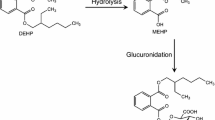Summary
N-Demethylation to phenobarbital is the only detectable monooxygenation pathway for (+)- and (−)-methylphenobarbital in rat liver microsomes. In microsomes from control ratsV max is about 3.5-fold higher for the (+)-isomer than for the (−)-form. This ratio increases significantly to 5 after pretreatment of rats with phenobarbital. Qualitatively similar but smaller ratios are found for the magnitude of the substrate binding spectra with corresponding values of 1.7 for control and 2.5 for phenobarbital treated rats.
The spectral dissociation constants (K s) and the distribution of both enantiomers between water and the microsomal membranes are not significantly different. Since only cytochrome P-450 is involved in the N-demethylation of both enantiomers the participation of two phenobarbital-inducible species of cytochrome P-450 with different Stereoselectivity is suggested. This is proved by inhibition studies with metyrapone which forms complexes more easily with the species responsible for the preferential binding and N-demethylation of the (+)-isomer of methyl phenobarbital.
Similar content being viewed by others
References
Alvares, A. P., Schilling, G., Levin, W., Kuntzmann, R.: Studies on the induction of CO-binding pigments in liver microsomes by phenobarbital and 3-methylcholanthrene. Biochem. biophys. Res. Commun.29, 521 (1967).
Bidleman, K., Mannerring, G. J.: Induction of drug metabolism V. Independent formation of cytochromes P-450 and P1-450 in rats treated with phenobarbital and 3-methylcholanthrene simultaneously. Molec. Pharmacol.6, 697 (1970).
Büch, H., Buzello, W., Neurohr, O., Rummel, W.: Vergleich von Verteilung, narkotischer Wirksamkeit und metabolischer Elimination der optischen Antipoden von Methylphenobarbital. Biochem. Pharmacol.17, 2391 (1968).
—, Grund, W., Buzello, W., Rummel, W.: Narkotische Wirksamkeit und Gewebsverteilung der optischen Antipoden des Pentobarbitals bei der Ratte. Biochem. Pharmacol.18, 1005 (1969).
—, Knabe, J., Buzello, W., Rummel, W.: Stereospecificity of anesthetic activity, distribution, inactivation, and protein binding of the optical antipodes of two N-methylated barbiturates. J. Pharmacol. exp. Ther.175, 705 (1970).
Butler, T. C.: Quantitative studies of the metabolic fate of mephobarbital. J. Pharmacol. exp. Ther.106, 235 (1952).
Degkwitz, E., Ullrich, V., Staudinger, Hj., Rummel, W.: Metabolism and cytochrome P-450 binding spectra of (+)-and (−)-hexobarbital in rat liver microsomes. Hoppe-Seylers Z. physiol. Chem.350, 547 (1969).
Diehl, H., Sohädelin, J., Ullrich, V.: Studies on the kinetics of cytochrome P-450 reduction in rat liver microsomes. Hoppe-Seylers Z. physiol. Chem.351, 1359 (1970).
Frommer, U., Ullrich, V., Staudinger, Hj.: Hydroxylation of aliphatic compounds by liver microsomes, I The distribution pattern of isomeric alcohols. Hoppe-Seylers Z. physiol. Chem.351, 903 (1970a).
Frommer, U., Ullrich, V., Staudinger, Hj.: Hydroxylation of aliphatic compounds by liver microsomes, II Effect of phenobarbital induction in rats on specific activity and cytochrome P-450 binding spectra. Hoppe-Seylers Z. physiol. Chem.351, 913 (1970b).
Frommer, U., Ullrich, V.: Hydroxylation of aliphatic compounds by liver microsomes, III Model hydroxylation reations. Z. Naturforsch, (in the press).
Furner, R. L., McCarthy, J. S., Stitzel, R. E., Anders, M. W.: Stereoselective metabolism of the enantiomers of hexobarbital. J. Pharmacol. exp. Ther.169, 2 (1969).
Gornall, A. G., Bardawill, C. J., David, M. M.: Determination of serum albumins by means of the biuret-reaction. J. biol. Chem.177, 751 (1949).
Hildebrandt, A. G., Leibman, K. C., Estabrook, R. W.: Metyrapone interaction with hepatic microsomal cytochrome P-450 from rats treated with phenobarbital. Biochem. biophys. Res. Commun.37, 477 (1969).
Knabe, J., Strauss, D., Urbahn, C.: Spaltung einiger recemischer Barbitale in optische Antipoden. Arch. Pharm. (Weinheim)299, 231 (1966).
Leibman, K. C.: Effects of metyrapone on liver microsomal drug oxidations. Molec. Pharmacol.5, 1 (1969).
Machinist, J. M., Orme-Johnson, W. H., Ziegler, D. M.: Microsomal oxidases. II. Properties of a pork liver microsomal N-oxide dealkylase. Biochemistry5, 2939 (1966).
Nash, T.: The colorimetric estimation of formaldehyde by means of the Hantzsch reaction. Biochem. J.55, 416 (1953).
Netter, K. J., Jenner, S., Kajuschke, K.: Über die Wirkung von Metyrapon auf den mikrosomalen Arzneimittelabbau. Naunyn-Schmiedebergs Arch. Pharmak. exp. Path.259, 1 (1967).
Omura, T., Sato, R.: The carbon monoxide-binding pigment of liver microsomes. II. Solubilization, purification, and properties. J. biol. Chem.239, 2379 (1964).
Peters, M. A., Fouts, J. R.: A study of some possible mechanisms by which magnesium activates hepatic microsomal drug metabolism in vitro. J. Pharmacol. exp. Ther.173, 233 (1970).
Peterson, J. A., Hildebrandt, A. G., Ullrich, V.: in preparation.
Remmer, H., Schenkman, J., Estabrook, R. W.: Reaktion von Arzneimittel mit mikrosomalen Cytochromen. Naunyn-Schmiedebergs Arch. Pharmak. exp. Path.255, 62 (1966).
Rummel, W., Brandenburger, U., Büch, H.: Versuche zur Aufklärung der Ursachen der unterschiedlichen narkotichen Wirksamkeit von (+)- und (−)-Hexobarbital. Med. Pharmacol. exp.16, 496 (1967).
Schenkman, J. B., Remmer, H., Estabrook, R. W.: Spectral Studies of drug interaction with hepatic microsomal cytochrome. Molec. Pharmacol.3, 113 (1967).
Sladek, N. E., Mannering, G. J.: Evidence for a new P-450 hemoprotein in hepatic microsomes from methylcholanthrene treated rats. Biochem. biophys. Res. Commun.24, 668 (1966).
Ullrich, V.: On the hydroxylation of cyclohexane in rat liver microsomes. Hoppe-Seylers Z. physiol. Chem.350, 357 (1969).
Wahlström, G.: Differences in anaesthetic properties between the optical antipodes of hexobarbital in the rat. Life Sci.5, 1781 (1966).
Williamson, D. G., O'Donnel, V.: The interaction of metopirone with adrenal mitochondrial cytochrome P-450. A mechanism for tho inhibition of adrenal steroid 11β-hydroxylation. Biochemistry8, 1306 (1969).
Ziegler, D. M., Mitchell, C., Jollow, D.: The properties of a purified hepatic microsomal mixed function amine oxidase. In: Microsomes and Drug Oxidation p. 173. J. R. Gillette, A. H. Conney, G. J. Cosmides, G. J., Estabrook, J. R. Fouts, G. J. Mannering, eds.). New York-London: Academic Press, 1969.
Author information
Authors and Affiliations
Additional information
This work was supported by the Deutsche Forschungsgemeinschaft, Schwerpunktsprogramm: Struktur und Funktion biologischer Membranen. We thank Prof. Dr. J. Knabe for the generous gift of (+)- and (-)-methylphenobarbital and Prof. Dr. W. Rummel and Dr. H. Büch for helpful discussions.
Rights and permissions
About this article
Cite this article
Bohn, W., Ullrich, V. & Staudinger, H. Species of cytochrome P-450 in rat liver microsomes with different stereoselectivity for the binding and monooxygenation of (+)- and (−)-methylphenobarbital. Naunyn-Schmiedebergs Arch. Pharmak. 270, 41–55 (1971). https://doi.org/10.1007/BF00997298
Received:
Issue Date:
DOI: https://doi.org/10.1007/BF00997298




